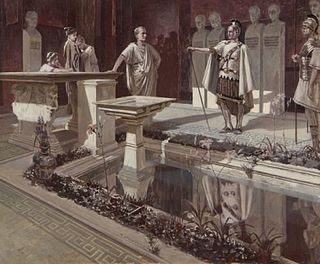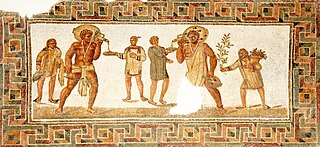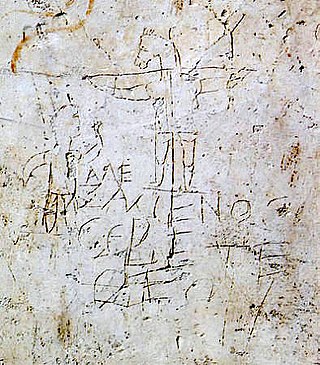
The Palatine Hill, which relative to the seven hills of Rome is the centremost, is one of the most ancient parts of the city and has been called "the first nucleus of the Roman Empire." The site is now mainly a large open-air museum while the Palatine Museum houses many finds from the excavations here and from other ancient Italian sites.

Aulus Plautius was a Roman politician and general of the mid-1st century. He began the Roman conquest of Britain in 43, and became the first governor of the new province, serving from 43 to 46.

Septimius Vaballathus was emperor of the Palmyrene Empire centred at Palmyra in the region of Syria. He came to power as a child under his regent mother Zenobia, who led a revolt against the Roman Empire and formed the independent Palmyrene Empire.

Homosexuality in ancient Rome often differs markedly from the contemporary West. Latin lacks words that would precisely translate "homosexual" and "heterosexual". The primary dichotomy of ancient Roman sexuality was active / dominant / masculine and passive / submissive / feminine. Roman society was patriarchal, and the freeborn male citizen possessed political liberty (libertas) and the right to rule both himself and his household (familia). "Virtue" (virtus) was seen as an active quality through which a man (vir) defined himself. The conquest mentality and "cult of virility" shaped same-sex relations. Roman men were free to enjoy sex with other males without a perceived loss of masculinity or social status, as long as they took the dominant or penetrative role. Acceptable male partners were slaves and former slaves, prostitutes, and entertainers, whose lifestyle placed them in the nebulous social realm of infamia, excluded from the normal protections accorded to a citizen even if they were technically free. Freeborn male minors were off limits at certain periods in Rome, though professional prostitutes and entertainers might remain sexually available well into adulthood.

Slavery in ancient Rome played an important role in society and the economy. Unskilled or low-skill slaves labored in the fields, mines, and mills with few opportunities for advancement and little chance of freedom. Skilled and educated slaves—including artisans, chefs, domestic staff and personal attendants, entertainers, business managers, accountants and bankers, educators at all levels, secretaries and librarians, civil servants, and physicians—occupied a more privileged tier of servitude and could hope to obtain freedom through one of several well-defined paths with protections under the law. The possibility of manumission and subsequent citizenship was a distinguishing feature of Rome's system of slavery, resulting in a significant and influential number of freedpersons in Roman society.

The Alexamenos graffito is a piece of Roman graffito scratched in plaster on the wall of a room near the Palatine Hill in Rome, Italy, which has now been removed and is in the Palatine Museum. It may be meant to depict Jesus; if so, it competes with an engraved gem held in the British Museum as the earliest known pictorial representation of the Crucifixion of Jesus. It is hard to date, but has been estimated to have been made at around the year 200. The image seems to show a young man worshipping a crucified, donkey-headed figure. The Greek inscription approximately translates to "Alexamenos worships [his] god," indicating that the graffito was apparently meant to mock a Christian named Alexamenos.
This is a timeline of Romanian history, comprising important legal and territorial changes and political events in Romania and its predecessor states. To read about the background to these events, see History of Romania.

In Roman Imperial cult, the flamen Divi Julii or flamen Divi Iulii, was the priest of the divinised Julius Caesar, and the fourth of the so-called flamines maiores to be created. The new flaminate was established by the Roman senate in 42 BC, as part of Caesar's consecration as a divus two years after his assassination. Caesar had, in his lifetime, been the recipient of unofficial, divine cult from his supporters, and had designated Mark Antony to serve as his priest. Caesar's cult continued after his death, and in 40 BC, the senate confirmed Antony as the first flamen Divi Iulii.
The gens Acerronia or Aceronia was a minor plebeian family at Rome during the late Republic and early Empire. The most distinguished member of the gens was Gnaeus Acerronius Proculus, consul in AD 37. A number of Acerronii are known from inscriptions.
Lucius Marcius Censorinus was a consul of the Roman Republic in 39 BC, during the Second Triumvirate. He and his colleague Gaius Calvisius Sabinus had been the only two senators who tried to defend Julius Caesar when he was assassinated on the Ides of March in 44 BC, and their consulship under the triumvirate was a recognition of their loyalty.

The Numerus Batavorum, also called the cohors Germanorum, Germani corporis custodes, Germani corpore custodes, Imperial German Bodyguard or Germanic bodyguard was a personal, imperial guards unit for the Roman emperors of the Julio-Claudian dynasty composed of Germanic soldiers. Although the Praetorians may be considered the Roman Emperor's main bodyguard, the Germanic bodyguards were a unit of more personal guards recruited from distant parts of the Empire, so they had no political or personal connections with Rome or the provinces.

Upper Alsace was a landgraviate of the Holy Roman Empire centred on Ensisheim and Landser, north of the County of Ferrette (Pfirt). The counts of Habsburg ruled the territory from the 1130s down to its cession to France in the 17th century.
Lucius Aemilius Carus was a Roman military officer and senator who served as consul suffectus for one of the nundinia in the first half of AD 144, with Quintus Egrilius Plarianus as his colleague. His life is known primarily through inscriptions.

The gens Rennia, occasionally written Renia, was an obscure plebeian family at ancient Rome. No members of this gens obtained any of the higher offices of the Roman state, but the family is known from inscriptions, and coins issued by a certain Gaius Renius, depicting the head of Roma on the obverse, and on the reverse Juno Caprotina in a chariot pulled by two goats.
The gens Bellia, also written Billia and Bilia, was an obscure plebeian family at ancient Rome. No members of this gens are mentioned in history, but several are known from inscriptions.

Contubernium was a quasi-marital relationship in ancient Rome between two slaves or between a slave (servus) and a free citizen or other free person. A slave involved in such a relationship was called contubernalis, the basic and general meaning of which was "companion."

The Palatine Museum is a museum located on the Palatine Hill in Rome. Founded in the second half of the 19th century, it houses sculptures, fragments of frescoes, and archaeological material discovered on the hill.
The gens Trebulana, occasionally spelled Treblana, was an obscure plebeian family at ancient Rome. No members of this gens are mentioned by Roman writers, but several are known from inscriptions, and at least one attained high office under the early Empire, as Publius Trebulanus was praetor urbanus in AD 30.
The gens Urbinia was an obscure plebeian family at ancient Rome. Only a few members of this gens are mentioned by Roman writers, but others are known from inscriptions.












